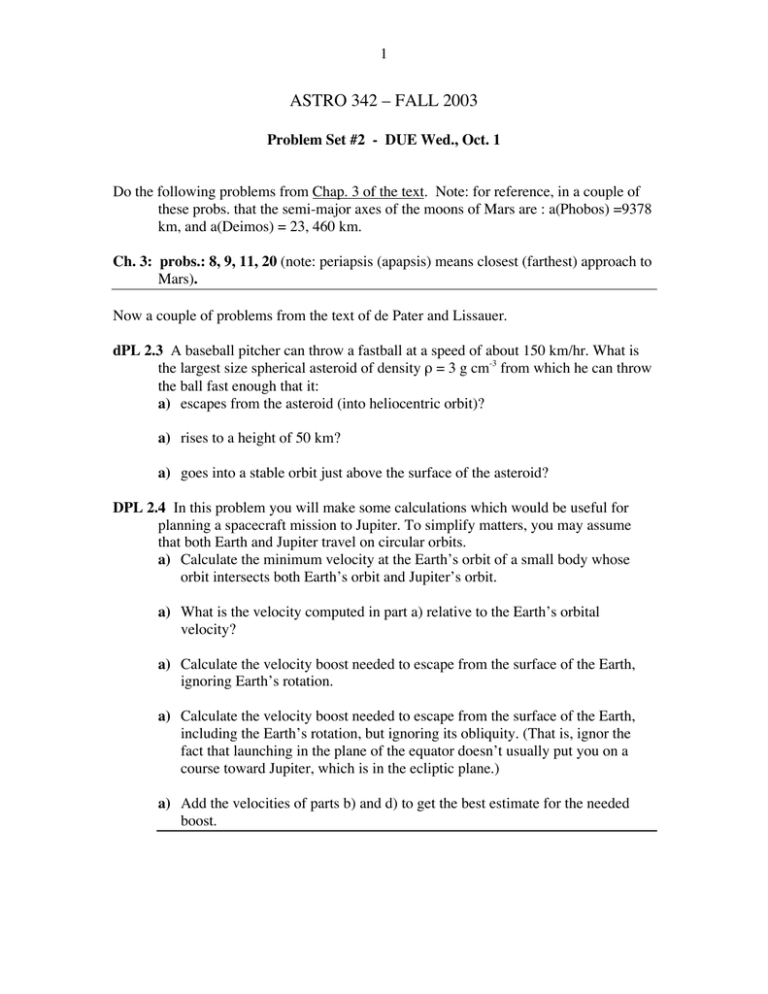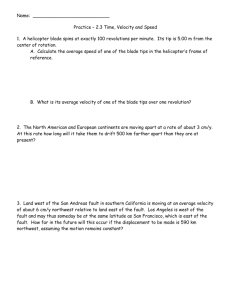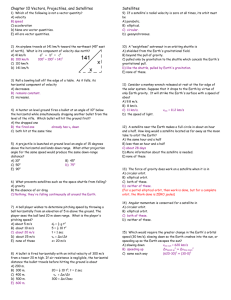ASTRO 342 – FALL 2003
advertisement

1 ASTRO 342 – FALL 2003 Problem Set #2 - DUE Wed., Oct. 1 Do the following problems from Chap. 3 of the text. Note: for reference, in a couple of these probs. that the semi-major axes of the moons of Mars are : a(Phobos) =9378 km, and a(Deimos) = 23, 460 km. Ch. 3: probs.: 8, 9, 11, 20 (note: periapsis (apapsis) means closest (farthest) approach to Mars). Now a couple of problems from the text of de Pater and Lissauer. dPL 2.3 A baseball pitcher can throw a fastball at a speed of about 150 km/hr. What is the largest size spherical asteroid of density r = 3 g cm-3 from which he can throw the ball fast enough that it: a) escapes from the asteroid (into heliocentric orbit)? a) rises to a height of 50 km? a) goes into a stable orbit just above the surface of the asteroid? DPL 2.4 In this problem you will make some calculations which would be useful for planning a spacecraft mission to Jupiter. To simplify matters, you may assume that both Earth and Jupiter travel on circular orbits. a) Calculate the minimum velocity at the Earth’s orbit of a small body whose orbit intersects both Earth’s orbit and Jupiter’s orbit. a) What is the velocity computed in part a) relative to the Earth’s orbital velocity? a) Calculate the velocity boost needed to escape from the surface of the Earth, ignoring Earth’s rotation. a) Calculate the velocity boost needed to escape from the surface of the Earth, including the Earth’s rotation, but ignoring its obliquity. (That is, ignor the fact that launching in the plane of the equator doesn’t usually put you on a course toward Jupiter, which is in the ecliptic plane.) a) Add the velocities of parts b) and d) to get the best estimate for the needed boost. 2 Additional problems 1. Either look up or derive explicit expressions for r- (closest approach) and r+ (farthest distance) in terms of the semi-major axis a, and the eccentricity e, for an elliptical orbit. What are the perihelion (closest approach to the Sun) and aphelion (farthest from the Sun) distances of Mercury? What are the perihelion and aphelion speeds of Mercury? Compute the product of the speed times the distance at these two points and compare. 2. A new comet is observed in the solar system. In the figure below, x-y axes are drawn in the plane of its orbit with the Sun at the origin. The current position of the comet is 3.0 astronomical units out on the y-axis. The comet’s velocity is determined to be vx = 8.7 km/s, vy = -18 km/s Comet at 3 a.u. Sun x a) What is the specific angular momentum (i.e., the angular momentum per unit mass of the comet? b) Prove that the comet is bound to the Sun. (Hint: you can determine the binding either by computing the comet’s energy, or by comparing the total velocity to the local escape velocity.) c) Determine the semi-major axis length a, and the eccentricity e of the orbit. 3. Consider 2 asteroids in the solar system, one on a circular orbit of radius R, and one on an elliptical orbit with a semi-major axis a = R, and eccentricity e = 0.7. a) How do their orbital periods compare? b) Which has the greater orbital energy? Explain. c) Which has the greater orbital angular momentum? Explain. 4. Suppose that our solar system consisted only of the planets: Earth, Jupiter and Neptune. Further suppose that these 3 planets were lined up on one side of the 3 Sun (on the axis, as shown below), at the moment that the Sun suffered a close encounter with another star, with the point of closest approach on the opposite side of the Sun. Assume that the Sun is located at x = 0.0, that the planets have positive x values, and that at the point of closest approach the star is at xca = -4.0 a.u. We can approximate the result of the encounter as an abrupt velocity change, or impulse, in the negative x direction imparted to the Sun and each of the planets. The magnitude of this impulse is proportional to both the gravitational attraction of the star and the duration of close approach, which is of order Dt = | xca|/vrel, where vrel is the relative velocity of the Sun and the star at closest approach. Thus, the magnitude of the velocity impulse is approximately, Dv = 2GMsun | xca | , Dx 2 vrel where Dx is the distance between the star and the planet (or Sun) under consideration. Assume vrel = 30 km/s. Star Jupiter Sun Earth Neptune a) Use the formula above to compute the velocity impulse on the Sun and the planets. Then compute the velocity difference between each planets and the Sun. (This is equivalent to transforming to a reference frame with the Sun at rest, and finding the planetary impulses in that frame.) b) Is Neptune still bound to the Sun after the collision? Extra Credit: (for die hard elliptical orbit fans!) Compute the elliptical orbit parameters a, e for all the planets that remain bound after the stellar collision. Comment on the future prospects for life on Earth. 5. The planar, restricted three-body problem has three unstable equilibrium (Lagrange) points on the x-axis of the rotating coordinate system, as discussed in class. These points are extrema of the effective potential F(x). When y=0 the potential is given by, 4 w 2 2 Gm1 Gm2 F= x + , 2 x-b x+ a where m1 is located at x=b, and m2 is located at x=-a. Refer to the diagram in the notes. Note that in the center of mass frame m1b = m2a. Define: m1 = m1 /(m1 + m2,), and m2 = m2 /(m1 + m2,). Also assume that the unit of length is defined such that a+b = 1. These relations and Kepler’s third law in the form, w2 = G(m1 + m2,)/(a+b)3, can be used to derive the following expression, ˆ Ê 1- m1 ˆ ˘ Èx2 Ê m1 Á ˜ -Á ˜ . F = (constant) ¥ + ÍÎ 2 Ë x - (1 - m1 ) ¯ Ë x + m1 ¯ ˙˚ Graph F vs. x for the cases m1 = 0.1, 0.5, 0.9. Identify the Lagrange points in each case and discuss how they move with respect to the positions of m1 and m2, as m1 (or the primary mass) is varied. (Note: because there are rapid changes, this is a tricky graphing problem. Be careful!)



